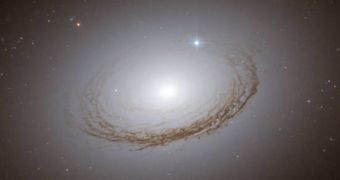The Constellation of Indus has recently revealed another of its galaxies to the Hubble Space Telescope. Dubbed the most important observatory in the history of astronomy, Hubble has managed to identify the NGC 7049 galactic formation in the Southern constellation, and to reveal that it has a very peculiar shape, somewhere between spiral and elliptical. NGC 7049 is also part of a large cluster of galaxies that reside in the constellation, known as the Brightest Cluster Galaxy (BCG).
Normally, astronomers say, this type of celestial formations contains some of the oldest-known galaxies in the Universe, and they provide astronomers and astrophysicists with invaluable resources in analyzing the elusive globular cluster formations that generally lie within. Globular clusters are galactic formations made up of hundreds of thousands of stars, but which are not spread across a galaxy, but rather form a satellite of sorts, orbiting the black hole in the middle. They look as the Moon would, if it was made of fireflies.
The new galaxy's core is surrounded by a number of dust rings, which are evidenced by the halo NGC 7049. This particular halo is not made from light reflecting off the dust, but from countless stars that reside outside the dusty rings. In the picture supplied by NASA and ESA, globular clusters appear as small points of light inside the galaxy itself. Astronomers suspect that these formations hold some of the first stars to be created in NGC 7049, and that analyzing them may provide insight into the galaxy's origin, history, and maybe even into its future development.
The Advanced Camera for Surveys instrument aboard Hubble has been used for these observations, as it is especially designed to be able to observe very distant galaxies and globular clusters. If the exposure time for the instrument is set correctly, Hubble can view traces of light and glows coming from galaxies located in the ancient Universe billions of years ago. The closest star to Earth in the Indus constellation is Epsilon Indi, located some 11.82 light-years away.

 14 DAY TRIAL //
14 DAY TRIAL //